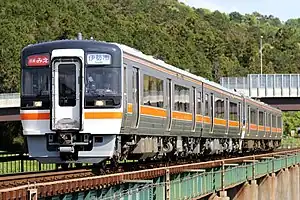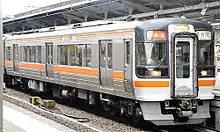| KiHa 75 | |
|---|---|
 KiHa 75 on a Mie rapid service, May 2019 | |
| In service | 1993–present |
| Manufacturer | Nippon Sharyo |
| Replaced | KiHa 58/65 series |
| Constructed | 1993–1999 |
| Entered service | 1 August 1993 |
| Number built | 40 vehicles (20 sets) |
| Number in service | 40 vehicles (20 sets) |
| Formation | 2 cars per set |
| Operators | JR Central |
| Depots | Nagoya |
| Lines served | Kansai Main Line, Sangū Line, Kisei Main Line, Takayama Main Line, Taita Line, Ise Line |
| Specifications | |
| Car body construction | Stainless steel |
| Car length | 20,800 mm (68 ft 3 in) |
| Width | 2,900 mm (9 ft 6 in) |
| Height | 3,630 mm (11 ft 11 in) |
| Doors | Three pairs per side |
| Maximum speed | 120 km/h (75 mph) |
| Prime mover(s) | C-DMF14HZB x2(Cummins N14 Series) |
| Power output | 350 hp per engine |
| Transmission | C-DW14A (hydraulic) |
| Bogies | C-DT60 (KiHa 75-0/100), C-DT60B (KiHa 75-200/300/400/500) |
| Track gauge | 1,067 mm (3 ft 6 in) |
The KiHa 75 (キハ75形) is a diesel multiple unit (DMU) train type operated by Central Japan Railway Company (JR Central) on Local, Rapid and Rapid Mie services in Japan since 1993.[1] They were also formerly used for the Kasuga Express service until it was discontinued in March 2006.
Variants
A total of 40 cars were built, operating as 2-car sets, with the class divided into three sub-classes: KiHa 75-0/100, KiHa 75-200/300, and KiHa 75-400/500.[2]
- KiHa 75-0/100: 6 x 2-car sets delivered June - July 1993
- KiHa 75-200/300: 8 x 2-car sets delivered February 1999
- KiHa 75-400/500: 6 x 2-car sets delivered February - March 1999, driver-only operation
KiHa 75-0 + KiHa 75-100
Twelve cars formed as six 2-car sets were delivered from Nippon Sharyo to Nagoya Depot in June and July 1993.[3] These entered service from the start of the revised timetable on 1 August 1993 on Mie rapid services, replacing ageing KiHa 58 and 65 series DMUs.[1]
Formation
| Designation | Mc1 | Mc2 |
|---|---|---|
| Numbering | KiHa 75-0 | KiHa 75-100 |
| Weight (t) | 38.5 | 37.8 |
| Capacity (Total/seated) |
129/52 | 134/56 |
Interior
The KiHa 75-0 cars have a universal access toilet, and were also initially equipped with a card-operated payphone, but this was subsequently removed.[3] Seating consists of transverse flip-over seats arranged 2+2 abreast.[3]
 Wheelchair-accessible toilet in car KiHa 75-4, March 2009
Wheelchair-accessible toilet in car KiHa 75-4, March 2009
KiHa 75-200 + KiHa 75-300

Sixteen cars formed as eight 2-car sets were delivered from Nippon Sharyo to Nagoya Depot in February 1999. These featured a number of minor changes compared with the earlier KiHa 75-0/100 sets. Externally, an additional set of headlights was included above the end gangway connections.[3]
Formation
| Numbering | KiHa 75-200 | KiHa 75-300 |
|---|---|---|
| Weight (t) | 40.2 | 39.4 |
| Capacity (Total/seated) |
133/52 | 138/56 |
Interior
The KiHa 75-200 cars have a universal access toilet, and were also initially equipped with a card-operated payphone, but this was subsequently removed.[3] The seating was the same design as that used on 313 series EMUs, still arranged in a transverse 2+2 abreast configuration.[3]
 Interior view of car KiHa 75-306, December 2008
Interior view of car KiHa 75-306, December 2008
KiHa 75-400 + KiHa 75-500

Twelve more cars formed as six 2-car sets were delivered from Nippon Sharyo to Nagoya Depot in February and March 1999. These were broadly similar to the KiHa 75-200/300 sets delivered at the same time, but were equipped for wanman driver only operation.[3]
Formation
The KiHa 75-400/500 sets are formed as follows.[4]
| Numbering | KiHa 75-400 | KiHa 75-500 |
|---|---|---|
| Weight (t) | 40.4 | 39.6 |
| Capacity (Total/seated) |
131/52 | 135/56 |
Interior
The KiHa 75-400 cars have a universal access toilet. Unlike the earlier sets, these cars were not fitted with a card-operated payphone.[3]
 Interior of car KiHa 75-403, March 2009
Interior of car KiHa 75-403, March 2009 Fare indicator panel of car KiHa 75-503, December 2008
Fare indicator panel of car KiHa 75-503, December 2008
References
- 1 2 Kobayashi, Kazuhiko (September 1993). "キハ75形気動車" [KiHa 75 DMU]. Japan Railfan Magazine. Vol. 33, no. 389. Japan: Koyusha Co., Ltd. pp. 51–54.
- ↑ JR全車輌ハンドブック2009 [JR Rolling Stock Handbook 2009]. Japan: Neko Publishing. 2009. ISBN 978-4-7770-0836-0.
- 1 2 3 4 5 6 7 8 Nishiwaki, Kōji (March 2011). "JR各社の新世代気動車の現状 JR東海キハ75形" [The Current Situation of JR Group Modern DMUs: JR Central KiHa 75]. Japan Railfan Magazine. Vol. 51, no. 599. Japan: Koyusha Co., Ltd. pp. 84–89.
- ↑ キハ75形・キハ11形増備車 [New batch of KiHa 75 and KiHa 11 DMUs]. Japan Railfan Magazine (in Japanese). Vol. 39, no. 459. Japan: Koyusha Co., Ltd. July 1999. pp. 100–101.
External links
- JR Central KiHa 75 information (in Japanese)
